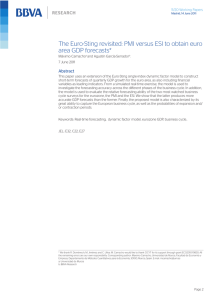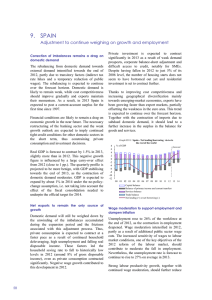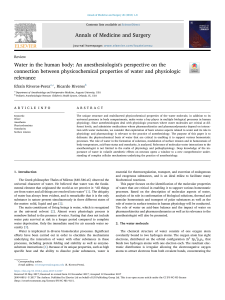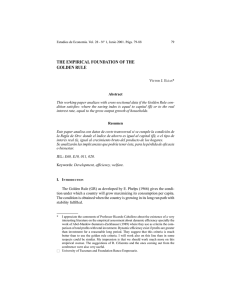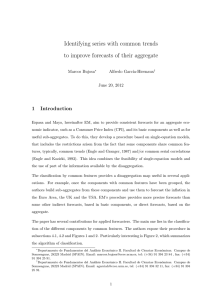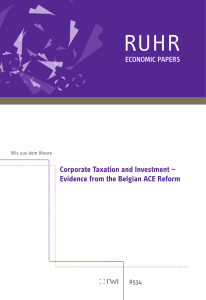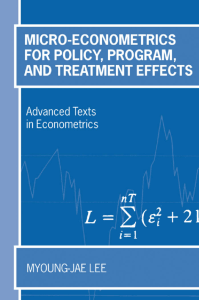The Robustness of the Effects of Public Investment in
Anuncio
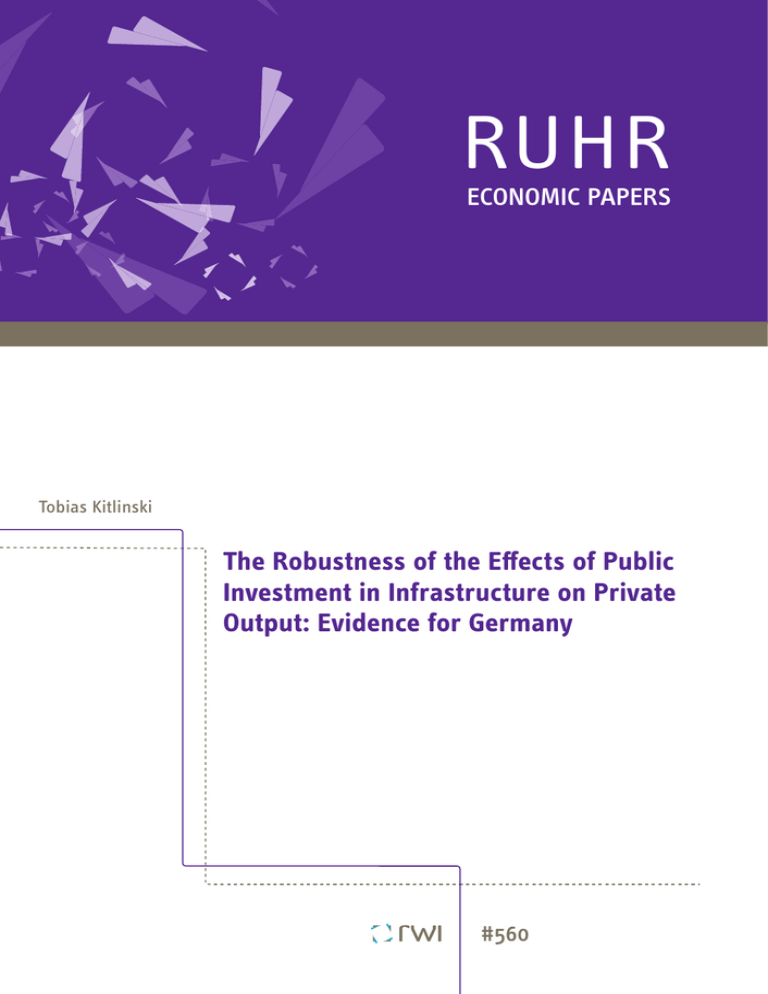
RUHR ECONOMIC PAPERS Tobias Kitlinski The Robustness of the Effects of Public Investment in Infrastructure on Private Output: Evidence for Germany #560 Imprint Ruhr Economic Papers Published by Ruhr-Universität Bochum (RUB), Department of Economics Universitätsstr. 150, 44801 Bochum, Germany Technische Universität Dortmund, Department of Economic and Social Sciences Vogelpothsweg 87, 44227 Dortmund, Germany Universität Duisburg-Essen, Department of Economics Universitätsstr. 12, 45117 Essen, Germany Rheinisch-Westfälisches Institut für Wirtschaftsforschung (RWI) Hohenzollernstr. 1-3, 45128 Essen, Germany Editors Prof. Dr. Thomas K. Bauer RUB, Department of Economics, Empirical Economics Phone: +49 (0) 234/3 22 83 41, e-mail: [email protected] Prof. Dr. Wolfgang Leininger Technische Universität Dortmund, Department of Economic and Social Sciences Economics – Microeconomics Phone: +49 (0) 231/7 55-3297, e-mail: [email protected] Prof. Dr. Volker Clausen University of Duisburg-Essen, Department of Economics International Economics Phone: +49 (0) 201/1 83-3655, e-mail: [email protected] Prof. Dr. Roland Döhrn, Prof. Dr. Manuel Frondel, Prof. Dr. Jochen Kluve RWI, Phone: +49 (0) 201/81 49 -213, e-mail: [email protected] Editorial Office Sabine Weiler RWI, Phone: +49 (0) 201/81 49 -213, e-mail: [email protected] Ruhr Economic Papers #560 Responsible Editor: Roland Döhrn All rights reserved. Bochum, Dortmund, Duisburg, Essen, Germany, 2015 ISSN 1864-4872 (online) – ISBN 978-3-86788-641-3 The working papers published in the Series constitute work in progress circulated to stimulate discussion and critical comments. Views expressed represent exclusively the authors’ own opinions and do not necessarily reflect those of the editors. Ruhr Economic Papers #560 Tobias Kitlinski The Robustness of the Effects of Public Investment in Infrastructure on Private Output: Evidence for Germany Bibliografische Informationen der Deutschen Nationalbibliothek Die Deutsche Bibliothek verzeichnet diese Publikation in der deutschen Nationalbibliografie; detaillierte bibliografische Daten sind im Internet über: http://dnb.d-nb.de abrufbar. http://dx.doi.org/10.4419/86788641 ISSN 1864-4872 (online) ISBN 978-3-86788-641-3 Tobias Kitlinski1 The Robustness of the Effects of Public Investment in Infrastructure on Private Output: Evidence for Germany Abstract This paper investigates the effects of public investment in infrastructure on private output for Germany. Using a multivariate framework we explore the impact of a diverging selection of variables on the ensuing estimates and document confidence intervals computed following the bootstrap procedure. Our results suggest that the effect of public investment in infrastructure is positive on GDP and private investment while the labor market is negatively affected. However, the size of the estimated effects strongly depends on the choice of the variables. Furthermore, an investigation of a recursive estimation reveals that the estimated effects decrease over time. JEL Classification: E6, H54, R4 Keywords: Public investment; infrastructure; vector autoregressive models; cointegration May 2015 1 Tobias Kitlinski, RWI. – I thank Michael Roos and Christoph M. Schmidt for helpful comments and suggestions. - All correspondence to: Tobias Kitlinski, e-mail: [email protected] 1 Introduction The discussions and analyses among policy makers and academics about the impact of public investment on the economy and especially on growth have been a recurring topic during the last two decades. However, the variation in the empirical results is very high, depending on the countries analyzed and the method and data used in each study. This paper investigates the effect of public investment in infrastructure on private output for Germany by applying a multivariate framework. In addition, different variables for public investment and the labor market are applied to analyze the robustness of the effects. Furthermore, we examine if the impact of public investment on private output changes over time by applying a recursive estimation. The empirical evaluation of the effects of public investment on overall economic performance started with Aschauer’s work (Aschauer 1989a; Aschauer 1989b) which initiated a large and still expanding literature. Aschauer (1989a) shows that a one percent increase in the public capital stock increased private output by 0.39 percent for the USA. Since then many studies followed, analyzing the effect of public investment on output for the USA and for many other countries.1 But the production function approach used by Aschauer was seriously challenged on econometric grounds (see Gramlich (1994) or Tatom (1991)). More precisely, after correcting the time-series for non-stationarity, the re-estimated results provide conflicting evidence, since the reported elasticities are lower than in the original studies (Pereira and Andraz 2011). Furthermore, the approach is limited since it is only a static single equation approach, ignoring simultaneity among the variables and non-contemporaneous effects.2 Most importantly, this approach assumes the direction of causality to run unequivocally from public investment to private output. But as Eisner (1991) and Hulten and Schwab (1993) concluded, causality may rather run stronger from output to public investment. These concerns led to the estimation using Vector Auto Regression (VAR) models including different variables for output, 1 Several surveys of the literature on public investment (see e.g. Munnell (1992), Gramlich (1994), Romp and de Haan (2007) or Pereira and Andraz (2011)) were published. 2 Hence, following studies that considered these concerns led to significantly lower effects of public capital (see Tatom (1991), Lynde (1992), Lynde and Richmond (1992) Lynde and Richmond (1993) or Vijverberg et al. (1997)). 4 the labor market, private capital and different variables for public investment (see e.g. Lau and Sin (1997), Batina (1998), Pereira (2001), Kamps (2005) or Jong-A-Pin and de Haan (2008)). Yet, another strand of the literature uses panel data. The estimated effects are often smaller in comparison to other approaches (see e.g. Dessus and Herrera (2000) or Kemmerling and Stephan (2002)). One of the advantages of using panel data is that more information is used and therefore a higher efficiency of the estimator is achieved (Kennedy 2008). Nevertheless, there are several disadvantages for panel estimation (see e.g. Baltagi (2013), Greene (2003) or Hsiao (2003)). In addition, spillover effects are mostly not considered in a panel estimation. Hence, the estimated effect might be too small. Furthermore, studies using panel data usually include only a short sample which might bias the results, too. The variety of findings are in the focus of severeal meta-analyses (see eg. Ligthart and Suárez (2005), Bom and Ligthart (2008) and Melo et al. (2013)), which analyze the determinants of differences across studies. All of the metaanalyses pay more or less attention to the following study characteristics: econometric estimation, model misspecification, data aggregation, measurement of public investment, country and time period and industrial sector. However, the existing meta-analyses only include studies that apply the production function approach.3 Yet some interesting patterns emerge from the analyses. The results of Ligthart and Suárez (2005) indicate that studies, which employ the variable core inf rastructure or use data at the national level find larger output elasticities of public capital than studies which apply a different approach. Bom and Ligthart (2008) conclude that the heterogeneity of results in the included studies are mainly due to differences in research design, such as the econometric specification, estimation technique, type of empirical model, type of public capital, and aggregation level of public capital. So far, both meta-analyses focus on a more broad definition of public capital. Instead, Melo et al. (2013) focus on the effect of transport infrastructure on private output. The results obtained from their metaanalysis suggest that studies which do not account for the urbanization levels or spatial spillover effects tend to produce higher elasticity estimates. Furthermore, 3 This is mainly due to the fact that most of the studies that belong to this field of research use the production function approach (Ligthart and Suárez 2005). 5 output elasticity of transport infrastructure tends to be larger for the US than for European countries. Overall, the existing meta-analyses show that the obtained results are highly sensitive to the choice of the empirical strategy. But there is, to the best of our knowledge, no meta-analysis that analyzes the effect of fundamentally different estimation approaches (VAR approach vs. production function approach). Furthermore, there is no analysis about the determinants of differences across studies that only apply the VAR approach. The empirical evidence for the effect of public infrastructure investment on private output for Germany is rather scarce and most of the papers do not use the latest data (see e.g. Mittnik and Neumann (2001), Kamps (2005), Finanzwissenschaftliches Forschungsinstitut an der Universität Köln (2006) or RheinischWestfälisches Institut für Wirtschaftsforschung (2010)). Hence, with this paper we contribute to existing literature by providing new empirical evidence for the estimated effect of public infrastructure on private output for Germany using the VAR approach. The second contribution of this paper is to explore the robustness of our results by applying different variables. Therefore, we apply VAR models for estimating the effect of public investment in infrastructure on private output since it has numerous advantages (Kamps 2005). First, VAR models do not impose any causal link between the variables like it is done in the production function approach. Furthermore, they allow testing if the causal relationship implied by the production function model is valid or whether there are feedback effects from outputs to inputs. Third, the VAR approach allows for indirect links between the different variables. For example, public investment does not only affect directly output but also indirectly via its effects on the private factors of production. Finally, the VAR approach does not assume that there is at most one long-run relationship among the model variables. We apply a four variable VAR, typically used in the literature (see e.g. Kamps (2005) or Jong-A-Pin and de Haan (2008)), to analyze the estimated effect of public investment in infrastructure on GDP, private investment and the labor market. More precisely, we apply the approach suggested by Johansen (1988) to detect the existence of cointegration in the data (Kremers et al. 1992). In the presence of cointegration we estimate a Vector Error Correction Model (VECM). We use three different variables for public investment in infrastructure and four different variables for the labor market to analyze the robustness of the results 6 according to the variance of the estimated effects in the sample 1970 − 2009. We follow Barro (1991), Mittnik and Neumann (2001) and Pereira and Andraz (2011), among other authors, and employ public investment rather than the capital stock. In the absence of reliable measures of the capital stock, using public investment is an acceptable alternative. Another strand of research applies the so-called perpetual inventory method to calculate the capital stock. Applying this approach, the researcher has to make assumptions about the assets’ lifetime and depreciation, and an initial level for the capital stock is needed. However, these assumptions are non-trivial. In a second step, we analyze the different estimated effects by impulse-response functions of the estimated models, focusing on long-term elasticities and show confidence intervals computed following the bootstrap procedure suggested by Hall (1988). Furthermore, we examine if the impact of public investment on private output changes over time by applying a recursive estimation. The high variability of the results obtained from our analysis documents that the choice of the variables matters for the concrete estimates, and consequently, for economic policy. On average, the estimated effect of public investment in infrastructure on GDP is 0.085 and on private investment 0.143. For the labor market the estimated effect is on average negative (−0.014). However, the effects are higher at the beginning of the sample and diminish over time. The paper is structured as follows: The next section briefly describes the econometric methodology used in the paper. Section 3 provides an overview of the data and its characteristics. The specification of the models is discussed as well. Section 4 presents the results of the estimated models and its impulseresponse functions. Furthermore, the results for a recursive window are presented. Section 5 summarizes and concludes. 2 2.1 Econometric Methodology The VAR model In recent years VAR models have become state of the art in analyzing the effect of public investment in infrastructure (Jong-A-Pin and de Haan 2008). Consider a p-th order vector autoregressive model, denoted VAR(p): 7 Yt = A1 Yt−1 + . . . + Ap Yt−p + ΦDt + μt (1) where Yt is a k-dimensional vector of time series variables, A, i = 0, 1, . . . , p, are matrices of coefficients, p is the lag order, Dt is a n-dimensional vector of deterministic variables and μt is a vector of innovations with zero mean and covariance matrix Ω. Generally, the VAR model can be estimated by ordinary least squares (OLS). This finding also holds for non-stationary variables (Sims et al. 1990). Therefore, many authors have ignored the problem of non-stationarity. Nevertheless, impulse-response functions and forecast error variance decompositions are inconsistent in the presence of non-stationary variables (Phillips 1998). Since impulseresponse functions are the main tool of analyzing the models, one should carefully address the existence of stationarity. Moreover, if all the variables are integrated of the same order, a test for cointegration should be applied. Many authors that followed this strategy used single-equation tests for this purpose, namely the Engle-Granger cointegration test (Engle and Granger 1987). However, this test verifies if there is only one possible cointegration vector. And since it relies on the simple Dicky-Fuller test (Dickey and Fuller 1979) for the residuals of a test equation, the power of this test is limited. As a consequence we use the more powerful approach suggested by Johansen (1988) that tests for more than just one possible cointegration. 2.2 The VECM model The VECM model resembles the VAR model but it is extended for the cointegration relationship. Therefore, we can rewrite equation (1) in the following vector autoregressive error correction form: ΔYt = ΠYt−1 + Γ1 ΔYt−1 + Γ2 ΔYt−2 + . . . + Γp−1 ΔYt−p+1 + ΦDt + μt (2) where Π denotes the cointegration vector. This specification confines the long-run behavior of the endogenous variables to converge to their cointegrating relationships. The Granger representation theorem stipulates that the matrix Π 8 has reduced rank r < k, i.e. Π = αβ , where α and β are k × r matrices of full column rank r and it applies that Π = αβ and β Yt is I(0) (Engle and Granger 1987). The determination of the number of cointegration vectors is provided by the Johansen approach that estimates the matrix Π from an unrestricted VAR with a maximum likelihood technique. In a second step it tests if the restrictions implied by the reduced rank of Π can be rejected. In our case of four variables for a model, there is cointegration if 0 < r < 4. This restriction implies three different cases. First, if the cointegration rank r = 0, then the rank Π = 0. This implies that the variables are not cointegrated and it is appropriate to estimate the VAR model in first differences. At the other end of the scale, if r = k, then the rank Π = k. This means that each variable must be stationary. Hence, the VAR can be estimated in levels by applying OLS. In the intermediate case, when 0 < r < k, the variables are driven by 0 < k − r < k common stochastic trends and rank Π = r < k. In this case, estimating by OLS is not appropriate. Besides the question whether a variable contains a unit root or not, the specification of the deterministic terms Dt in equation 2 can influence the results of the test. Johansen (1995) distinguishes five alternative models, corresponding to alternative sets of restrictions on the deterministic terms. However, two specifications are usually applied in the empirical literature (Franses 2001). In the following, we choose for each model the relevant specification for our analysis.4 2.3 Impulse-Response Function with confidence intervals After estimating a VAR or VECM model we explore the impact of a change in one variable on another. But a shock to one variable affects all variables through the dynamic lag structure of the model. Since the errors in equation (1) and (2) are correlated with each other, we cannot interpret the impulse-response functions directly. Instead, we have to apply a transformation to the innovations so that they become uncorrelated and we can identify the model. In the empirical literature, the dynamic analysis of VAR models is routinely carried out by using the Cholesky decomposition. However, this approach is sensitive to the ordering 4 Nevertheless, we estimate the models with both specifications to check if the choice has an influence on the results. But the differences in the long run are negligible. However, this could have had an influence on the results of other studies. 9 of the variables which can have a significant impact on the results of the impulseresponses functions. To avoid such an impact on the results, we use the method of Generalized Impulses as described by Pesaran and Shin (1998). It creates an orthogonal set of innovations that does not depend on the VAR ordering. In addition, many studies analyzing effects of different variables by using impulse-response functions do not account for statistic significance in terms of confidence intervals. In particular this applies to studies where VECM models are used. Therefore we apply the bootstrap procedure that can be generally summarized as follows (Kamps 2005): 1. Estimate the parameters of the model (2). 2. Generate bootstrap residuals μ∗1 , ..., μ∗T by randomly drawing with replacement from the estimated residuals μˆ1 , ..., μˆT . 3. Construct bootstrap time series Yt∗ recursively using equation 2 under the ∗ condition that the pre-sample values (Yt−p+1 , ..., Y0∗ ) = (Yt−p+1 , ..., Y0 ), ∗ ∗ Yt∗ = Â1 Yt−1 + ... + Âp Yt−p + Φ̂Dt + μ∗t , t = 1, ..., T . 4. Re-estimate the parameters from the generated data and calculate the impulse-response functions. 5. Repeat steps 2 − 4 for a large number of times and calculate the α and 1 − α percentile interval endpoints of the distribution of the individual elements of the impulse-response function. More precisely, we apply a bootstrapping method suggested by Hall (1988) to make statements about statistical significance. Unfortunately, the bootstrap procedure does not always result in confidence intervals with the desired coverage, even asymptotically (Benkwitz et al. 2000). Nevertheless, it indicates the estimation uncertainty. 3 3.1 Data and first empirical analysis Data To analyze the effect of public investment in infrastructure on private output we use annual data for the period from 1970 to 2009. The data are obtained from the 10 Federal Ministry of Transport, Building and Urban Development (MTBUD) and the Federal Statistical Office (FSO). The data from the MTBUD includes time series for public investment (pinv), here in terms of infrastructure investment, divided in different sub-categories. Gross Domestic Product (GDP), and private investment (inv) originate from the FSO. The latter is calculated as gross fixed capital formation less public investment. Typically, one of the variables that are considered in the VAR approach belongs to the labor market. Therefore, we include various variables for the labor market, namely labor force and employees, to analyze their different influence on the results. Many of the published studies dealing with public investment and its effect on private output utilize only the number of workers for the labor force or the number of the employees. But there are good reasons to use the hours worked instead, since the same number of the labor force or the employees may work different hours. Furthermore, hours worked decreased in the past while the number of workers increased. This implies a low correlation between both variables. Jong-A-Pin and de Haan (2008) showed that the choice of the variable for the labor market can lead to rather different results. Hence, we consider both variations for the labor force and the employees to explore how they influence the results for Germany. While we use only one category for private investment we apply different sub-categories for public infrastructure investment. In Table 1 we present some descriptive statistics on the composition and importance of different categories for public investment in Traffic infrastructure in Germany. First, this investment can be divided into two main sub-categories, namely Trans-shipment-centers (11.2%) and Transportation routes (88.8%). The latter is further subdivided into five categories. Investment in Railroads accounts for 11.5% of total public investment in Traffic infrastructure in the beginning of the sample and increases to 21.6% in the years after reunification. In 2009, the last year in the sample, it accounts for almost 13%. The second type of investment in Transportation routes is investment in Tramways. Its share is around 5% and decreases after reunification. The third type of investment in transportation routes is investment in Road and Bridges. It represents 61.3% of investment in Traffic infrastructure in 2009 shows its peak in the 1970s and 1980s with more than 70%. In the years after reunification it declines to 55.6% but this includes the counter-effect after the 11 construction boom in the 1990s in Germany. The next type of public investment in Traffic infrastructure is concerns the provision of Waterways. Its share is around 3.3% and increases in more recent years. The last category deals with the transport by Pipelines. In 2009 it accounts for 1.1% of investment in Traffic infrastructure. In general, aggregate investment in Traffic infrastructure in relation to GDP declines over the whole sample. With 0.7% in 2009 it shows an historical low. The data indicates that the general decline is mostly due to the decline in investment in Road and Bridges. More generally, there is a shift from investment in Transportation routes to investment in Trans-shipment-centres. For our empirical analysis we choose three different variables for public investment in infrastructure. First, we take the total investment in Traffic infrastructure. Second, we consider Transportation routes as the variable for public investment, since it accounts for almost 90% of total investment in Traffic infrastructure. Next, we take the sub-category Road and Bridges as a variable for our models for two reasons. First, as the main sub-catogry it constitutes 60% of whole investment in Traffic infrastructure. Second, Road and Bridges play an important role in providing access to territory and allowed the improvement of movement of people and goods. Considering three different variables for public investment in infrastructure and four variables for the labor market we explore the robustness of the results according to the variance of the estimated effects. Expressing the variables in natural logarithms multiplied by 100 facilitates the interpretation of the results of the impulse-response functions. They reflect the percentage change in the level of the considered variable. 3.2 Specification of the models In the early years of research on the effect of public investment, non-stationarity and its impact on the results were ignored. Later, most studies used the augmented ADF-test. But the low power of the augmented ADF-test, especially for short time series, requires additional tests. Therefore, besides the augmented ADF-test we employ a second test for unit roots, the so called Phillips-Peron test (PP-test) (Phillips and Perron 1988). For both of them, the Schwarz-InformationCriterion is used to determine the optimal number of lagged differences included 12 in the test equation. Furthermore, we include an intercept and/or trend in the equation if they are statistically significant. Both tests indicate for the most of the variables that they are integrated of order one. Only the variables for the labor market that use hours instead of number of people indicate in some constellations stationarity in levels (Table 2 and Table 3). Nevertheless, we treat all variables as integrated of order one, since it is commonly accepted that most of macroeconomic time series are I1. In a next step we test for cointegration. We apply the Johansen-Cointegration Test (Johansen 1991) since we do not know a priori how many cointegration relations exist. The results of the cointegration test for the different variable constellations are reported in Table 4. We find for most models one cointegration equation at the significance level α = 0.95, applying the specification that includes levels of Yt with deterministic trends and cointegration vectors with unrestricted intercepts. Nevertheless, Table 4 shows the results for the other specifications. So far we have determined that all variables are I = 1, i.e. all of them have the same order of integration. Furthermore, they are cointegrated with cointegration rank r = 1. Thus, we continue by applying VECM and can use levels instead of first differences what imply a loss of information. All in all we estimate 12 different models.5 Each model is optimized with respect to its lag length based on the Schwarz information criterion (Schwarz 1978).6 4 Empirical Results In this section we present the estimated effects of different VECM models for Germany with a special emphasis on the differences between them. We start with the results of the impulse-response functions which are based on the different models and present the estimated confidence intervals, even if they indicate that the effects are statistically not significant.7 Second, we show the results of a recursive scheme for each model and compare the results. 5 The 12 models originate from combination of the different variables. We use three different variables for public investment in infrastructure and four different variables for the labor market. 6 If we find still residual autocorrelation in the model we increase the number of lags up to a maximum of two until there is no autocorrelation left. 7 Bootstrapped intervals often do not show the desired coverage (Benkwitz et al. 2000). Nevertheless, the estimated intervals indicate the estimation uncertainty. 13 4.1 Impulse Response Function Analysis Figure 1 shows the impulse-responses for GDP, private investment and the corresponding variable for the labor market to a one-standard-deviation shock to each variable of public investment in infrastructure for a horizon of 20 years for the different models. Besides the impulse responses a 90% confidence interval is shown for each model calculated by applying the bootstrap procedure (Hall 1988). First of all, it is obvious that higher investment in public infrastructure crowds in private investment, independently from the different variables used in the models (Table 5). Only model 6 shows an effect of zero.8 Next, the estimated effect of public investment on GDP is in general positive. Again, the result of model 6 differs from the other models as the effect of public investment in infrastructure on GDP is almost zero, as well as for private investment. Third, the estimated effect on the labor market is almost zero or even negative. Only two out of 12 models show a response that is slightly above the zero line.9 Furthermore, most of the impulse-response functions are not significant and the confidence intervals show a wide range (Benkwitz et al. 2000). This is mainly due to the few observations since we have to use yearly data. These results simply show that estimating the effect of public investment is not as straightforward as it is often claimed. More precisely, the size of the estimated effects differs substantially, depending on the choice of the variables. Remember that the same approach is used for all calculations. Table 6 shows the results of the impulse-response functions in terms of the calculated long-term elasticities. For GDP the average elasticity is 0.085 which is substantially lower than the 0.39 of Aschauer. However, depending of the choice of variables, the calculated elasticities vary between −0.008 and 0.187. Next, for private investment the estimated elasticities are between 0.008 and 0.286. The average is 0.143. Finally, for the labor market the values vary between −0.052 and 0.030. Here, the average is −0.014. So far, our results are in line with the existing literature. The estimated elasticities of public investment in infrastructure on GDP in the different metaanalyses ranged between 0.14 (Ligthart and Suárez 2005) and 0.064 (Bom and 8 This model consists of the four variables: GDP, private investment, labor force (hours) and transportation routes. 9 Model 10: GDP, private investment, labor force (hours) and Road &Bridges and model 12: GDP, private investment, employees (hours) and Road & Bridges. 14 Ligthart 2008). Remember, the average elasticity of the 12 models we estimated is 0.085. For private investment and the labor market, the meta-analyses do not provide any elasticity to compare with our results. Nevertheless, Kamps (2005) estimated an elasticity for private investment of 0.22 and for the labor market of −0, 12 for Germany while we estimated an average elasticity of 0.143 and −0.014, respectively. 4.2 Recursive Estimation In this subsection we report the results for recursive estimation of the models. Thereby we analyze, if the estimated effects in section 4.1 are stable or if they rather change over time. We start with the sample 1970 − 1995 for all models and calculate long run elasticities for them. Next, we add one year and calculate the elasticities again. The last estimation includes the whole sample (1970 − 2009). We adopt for all models the same number of cointegrations and lags as found for the full sample. Table 7 presents the results. While the estimated effect of public investment in infrastructure on GDP is almost stable and shows for some models only a slight decline, the effect on private investment decreases over time. This result is not surprising as the level of the public capital stock has increased, thereby resulting in decreasing marginal returns. For the labor market the effect is positive in the beginning of the sample but the more years are added to the recursive estimation the weaker is the effect and finally turns negative. Table 8 shows the results of regressions where the calculated long term elasticities are regressed on a time trend. For most of the regressions the estimated coefficient of the trend variable is negative, suggesting that public capital has become less productive. For private investment all coefficients are negative and statistically significant, suggesting that public capital has crowded in less private investment over time. Conversely, for GDP the coefficients are on average zero and only a few of them are significant. For the labor market the recursive estimation confirms the result that the positive effect of public capital at the beginning of the sample turned negative over time. To sum it up, we can state the following. First, the average effect of public investment in infrastructure seems to be positive for GDP and private investment for Germany. But the positive effect diminishes over time. Next, for the labor 15 market we find only a positive effect at the beginning of the recursive estimation sample. For the whole sample, the estimated effect is negative. Third, these findings depend strongly on the choice of the variables and are not significant. 5 Conclusions In this paper we estimate the effect of public investment in infrastructure on private output for Germany. For this task we set up a four-variable multivariate framework including GDP, private investment and three different variables for public investment and four different variables for the labor market to analyze the robustness of the results. The different estimated effects are analyzed by long-term elasticities of the estimated models. Furthermore, we apply a recursive estimation scheme to analyze if the impact of public investment in infrastructure on private output differs over time. Our investigation reveals that the choice of the variables influences the size of the estimated effects of public investment in infrastructure on private output. Nevertheless, in general the estimated effects of public investment are on average positive for GDP and private investment while the point estimations of the effect for the labor market are negative. However, all the estimated effects of public investment on the other variables are statistically not significant. Furthermore, the effects are higher at the beginning of the chosen sample and diminish over time. All in all, we provide evidence that the large estimates found in the early studies seem to be too high. In addition, we highlight that the size of the estimated effects strongly depend on the choice of the variables and on the chosen sample. Therefore, our analysis cannot provide a clear answer to the ”true” value of the effect of public investment in infrastructure on private output for Germany but at least call attention to the high sensitivity of the estimations to the concrete choice of the empirical strategy. 16 References Aschauer, D. (1989a). Is public expenditure productive? Journal of Monetary Economics 23 (2), 177–200. Aschauer, D. A. (1989b, September). Does public capital crowd out private capital? Journal of Monetary Economics 24 (2), 171–188. Baltagi, B. (2013). Econometric analysis of panel data (5. ed. ed.). Wiley. Barro, R. J. (1991, May). Economic Growth in a Cross Section of Countries. The Quarterly Journal of Economics 106 (2), 407–43. Batina, R. (1998, July). On the Long Run Effects of Public Capital and Disaggregated Public Capital on Aggregate Output. International Tax and Public Finance 5 (3), 263–281. Benkwitz, A., H. Lütkepohl, and M. Neumann (2000). Problems related to bootstrapping impulse responses of autoregressive processes. Econometric Reviews 19, 69–103. Bom, P. R. D. and J. Ligthart (2008). How Productive is Public Capital? A Meta-Analysis. CESifo Working Paper Series 2206, CESifo Group Munich. Dessus, S. and R. Herrera (2000, January). Public Capital and Growth Revisited: A Panel Data Assessment. Economic Development and Cultural Change 48 (2), 407–18. Dickey, D. A. and W. A. Fuller (1979). Distribution of the Estimators for Autoregressive Time Series With a Unit Root. Journal of the American Statistical Association 74 (366), 427–431. Eisner, R. (1991). Infrastructure and regional economic performance: comment. New England Economic Review (Sep), 47–58. Engle, R. F. and C. W. J. Granger (1987, March). Co-integration and Error Correction: Representation, Estimation, and Testing. Econometrica 55 (2), 251–76. Finanzwissenschaftliches Forschungsinstitut an der Universität Köln (2006). Wachstumswirksamkeit von Verkehrsinvestitionen in Deutschland. Technical Report FiFo-Berichte Nr. 7, Team: Bertenrath, R. and Thöne, M. and Walter, C. Forschungsauftrag 13/04 des Bundesministeriums der Finanzen. I Franses, P. H. (2001). How to deal with intercept and trend in practical cointegration analysis? Applied Economics 33 (5), 577–579. Gramlich, E. M. (1994). Infrastructure Investment: A Review Essay. Journal of Economic Literature 32 (3), 1176–1196. Greene, W. H. (2003). Econometric Analysis (5. ed.). Upper Saddle River, NJ: Prentice Hall. Hall, P. (1988). On Symmetric Bootstrap Confidence Intervals. Journal of the Royal Statistical Society. Series B (Methodological) 50 (1), pp. 35–45. Hsiao, C. (2003). Analysis of Panel Data (Second ed.). Cambridge University Press. Cambridge Books Online. Hulten, C. R. and R. M. Schwab (1993, Sep). Infrastructure spending: where do we go from here? National Tax Journal 46 (3), 261–274. Johansen, S. (1988). Statistical analysis of cointegration vectors. Journal of Economic Dynamics and Control 12 (2-3), 231–254. Johansen, S. (1991, November). Estimation and Hypothesis Testing of Cointegration Vectors in Gaussian Vector Autoregressive Models. Econometrica 59 (6), 1551–80. Johansen, S. (1995). Likelihood-Based Inference in Cointegrated Vector Autoregressive Models. Oxford University Press. Jong-A-Pin, R. and J. de Haan (2008, July). Time-varying impact of public capital on output: New evidence based on VARs for OECD countries. EIB Papers 3/2008, European Investment Bank, Economic and Financial Studies. Kamps, C. (2005, August). The Dynamic Effects of Public Capital: VAR Evidence for 22 OECD Countries. International Tax and Public Finance 12 (4), 533–558. Kemmerling, A. and A. Stephan (2002, December). The Contribution of Local Public Infrastructure to Private Productivity and Its Political Economy: Evidence from a Panel of Large German Cities. Public Choice 113 (3-4), 403–24. II Kennedy, P. (2008). A Guide to Econometrics (6 ed.), Volume 1. The MIT Press. Kremers, J. J. M., N. R. Ericsson, and J. J. Dolado (1992, August). The Power of Cointegration Tests. Oxford Bulletin of Economics and Statistics 54 (3), 325–48. Lau, S.-H. P. and C.-Y. Sin (1997). Public Infrastructure and Economic Growth: Time-Series Properties and Evidence*. Economic Record 73 (221), 125–135. Ligthart, J. and R. Suárez (2005). The Productivity of Public Capital: A Meta Analysis. Working paper, Tilburg University. Lynde, C. (1992). Private profit and public capital. Journal of Macroeconomics 14 (1), 125 – 142. Lynde, C. and J. Richmond (1992, February). The Role of Public Capital in Production. The Review of Economics and Statistics 74 (1), 37–44. Lynde, C. and J. Richmond (1993). Public Capital and Total Factor Productivity. International Economic Review 34 (2), pp. 401–414. Melo, P. C., D. J. Graham, and R. Brage-Ardao (2013). The productivity of transport infrastructure investment: A meta-analysis of empirical evidence. Regional Science and Urban Economics 43 (5), 695–706. Mittnik, S. and T. Neumann (2001). Dynamic effects of public investment: Vector autoregressive evidence from six industrialized countries. Empirical Economics 26 (2), 429–446. Munnell, A. H. (1992). Policy Watch: Infrastructure Investment and Economic Growth. The Journal of Economic Perspectives 6 (4), pp. 189–198. Pereira, A. M. (2001). On the Effects of Public Investment on Private Investment: What Crowds in What? Public Finance Review 29, 3–25. Pereira, A. M. and J. M. Andraz (2011, January). On the economic effects of public infrastructure investment:A survey of the international evidence. Working Papers 108, Department of Economics, College of William and Mary. III Pesaran, M. H. and Y. Shin (1998, January). Generalized impulse response analysis in linear multivariate models. Economics Letters 58 (1), 17–29. Phillips, P. C. B. (1998). Impulse response and forecast error variance asymptotics in nonstationary VARs. Journal of Econometrics 83 (1-2), 21–56. Phillips, P. C. B. and P. Perron (1988). Testing for a Unit Root in Time Series Regression. Biometrika 75 (2), 335–346. Rheinisch-Westfälisches Institut für Wirtschaftsforschung (2010). Verkehrsinfrastrukturinvestitionen - Wachstumsaspekte im Rahmen einer gestaltenden Finanzpolitik. Technical report, Team: Barabas, G. and Brilon, W. and Kitlinski, T. and Schmidt, C.M. and Schmidt, T. and Siemers, L.-H. Forschungsprojekt im Auftrag des Bundesministeriums der Finanzen. Romp, W. and J. de Haan (2007, 04). Public Capital and Economic Growth: A Critical Survey. Perspektiven der Wirtschaftspolitik 8 (s1), 6–52. Schwarz, G. (1978). Estimating the dimension of a model. The annals of statistics 6 (2), 461–464. Sims, C. A., J. H. Stock, and M. W. Watson (1990, January). Inference in Linear Time Series Models with Some Unit Roots. Econometrica 58 (1), 113–44. Tatom, J. A. (1991, May). Public capital and private sector performance. Federal Reserve Bank of St. Louis Review 73 (3), 3–15. Vijverberg, W. P. M., C.-P. C. Vijverberg, and J. L. Gamble (1997, May). Public Capital And Private Productivity. The Review of Economics and Statistics 79 (2), 267–278. IV 6 6.1 Appendix A:Graphs Figure 1 Model 1 P.IN V L.F ORCEN GDP 10 5 6 2 4 1 0 2 0 −1 0 5 10 15 periods 5 20 10 15 periods 20 −2 5 10 15 periods 20 Note: The figures show the impulse response of output to a one-standard-deviation shock to public investment over a period of 20 years. The VECM includes four variables (Traffic infrastructure, GDP, private investment, labor force (numbers)), one lag and one cointegration. Model 2 L.F ORCEH GDP P.IN V 8 6 4 2 0 −2 2 3 2 1 1 0 0 5 10 15 periods 20 −1 5 10 15 periods 20 −1 5 10 15 periods 20 Note: The figures show the impulse response of output to a one-standard-deviation shock to public investment over a period of 10 years. The VECM includes four variables (Traffic infrastructure, GDP, private investment, labor force (hours)), one lag and one cointegration. V Model 3 P.IN V EmplN GDP 2 8 6 4 4 2 0 0 −1 1 2 0 5 10 15 periods 20 5 10 15 periods 20 −2 5 10 15 periods 20 Note: The figures show the impulse response of output to a one-standard-deviation shock to public investment over a period of 10 years. The VECM includes four variables (Traffic infrastructure, GDP, private investment, employees (numbers)), one lag and one cointegration. Model 4 EM P LH GDP P.IN V 4 6 2 1 4 2 2 0 0 −2 −1 0 5 10 15 periods 20 5 10 15 periods 20 −2 5 10 15 periods 20 Note: The figures show the impulse response of output to a one-standard-deviation shock to public investment over a period of 10 years. The VECM includes four variables (Traffic infrastructure, GDP, private investment, employees (hours)), one lag and one cointegration. Model 5 L.F ORCEN GDP P.IN V 4 6 2 1 4 2 2 0 −2 0 −1 0 5 10 15 periods 20 5 10 15 periods 20 −2 5 10 15 periods 20 Note: The figures show the impulse response of output to a one-standard-deviation shock to public investment over a period of 10 years. The VECM includes four variables (Transportation routes, GDP, private investment, labor force (numbers)), one lag and one cointegration. VI Model 6 4 2 0 −2 5 10 15 periods L.F ORCEH GDP P.IN V 20 2 2 1 1 0 0 −1 −1 −2 5 10 15 periods 20 −2 5 10 15 periods 20 Note: The figures show the impulse response of output to a one-standard-deviation shock to public investment over a period of 10 years. The VECM includes four variables (Transportation routes, GDP, private investment, labor force (hours)), one lag and one cointegration. Model 7 P.IN V EM P LN GDP 2 6 4 1 4 2 0 −2 5 10 15 periods 2 0 0 −1 20 5 10 15 periods 20 −2 5 10 15 periods 20 Note: The figures show the impulse response of output to a one-standard-deviation shock to public investment over a period of 10 years. The VECM includes four variables (Transportation routes, GDP, private investment, employees (numbers)), one lag and one cointegration. Model 8 6 4 2 0 −2 5 10 15 periods EM P LH GDP P.IN V 20 2 2 1 1 0 0 −1 −1 −2 5 10 15 periods 20 −2 5 10 15 periods 20 Note:The figures show the impulse response of output to a one-standard-deviation shock to public investment over a period of 10 years. The VECM includes four variables (Transportation routes, GDP, private investment, employees (hours)), one lag and one cointegration. VII Model 9 P.IN V L.F ORCEN GDP 4 8 6 4 2 0 −2 2 1 2 0 0 5 10 15 periods 20 −1 −2 5 10 15 periods 20 −2 5 10 15 periods 20 Note: The figures show the impulse response of output to a one-standard-deviation shock to public investment over a period of 10 years. The VECM includes four variables (Road and bridges, GDP, private investment, labor force (numbers)), one lag and one cointegration. Model 10 P.IN V L.F ORCEH GDP 2 2 4 1 2 0 0 −1 −2 5 10 15 periods 20 1 0 −2 5 10 15 periods 20 −1 5 10 15 periods 20 Note: The figures show the impulse response of output to a one-standard-deviation shock to public investment over a period of 10 years. The VECM includes four variables (Road and bridges, GDP, private investment, labor force (hours)), one lag and one cointegration. Model 11 EM P LN GDP P.IN V 8 3 6 2 4 1 2 1 0 −1 0 0 5 10 15 periods 20 −1 5 10 15 periods 20 −2 5 10 15 periods 20 Note: The figures show the impulse response of output to a one-standard-deviation shock to public investment over a period of 10 years. The VECM includes four variables (Road and bridges, GDP, private investment, employees (numbers)), one lag and one cointegration. VIII Model 12 P.IN V EM P LH GDP 10 5 8 2 6 1 4 0 2 −1 0 0 5 10 15 periods 20 5 10 15 periods 20 −2 5 10 15 periods 20 Note: The figures show the impulse response of output to a one-standard-deviation shock to public investment over a period of 10 years. The VECM includes four variables (Road and bridges, GDP, private investment, employees (hours)), one lag and one cointegration. 6.2 B:Tables Table 1: Summary Statistics on the Importance and Composition of public investment in infrastructure in Germany Investment in traffic infrastructure Trans-Shipment-Centers Transportation routes including: Railroad Tramways Road & Bridges Waterways Transport by pipeline % Share of GDP 1970-1989 7.6 92.4 11.5 5.2 72.2 3.0 0.5 1.6 1990-2009 13.7 86.3 21.6 4.8 55.6 3.4 0.9 1.0 1970-2009 11.2 88.8 17.5 5.0 62.4 3.3 0.7 1.2 2009 14.9 85.1 12.9 4.1 61.3 5.8 1.1 0.7 Note: The numbers show the composition of investment in traffic infrastructure and its share in relation to GDP. IX X hours worked (Employees) Employees hours worked (Labor force) Labor force GDP Private investment Road and Bridges Transportation routes Traffic infrastructure ADF-Test trend o o x o o x o o x o o x o o x o o x o o x o o x o o x constant o x x o x x o x x o x x o x x o x x o x x o x x o x x -0.29 -1.84 -1.81 -0.39 -1.98 -1.95 -0.66 -2.06 -2.06 2.06 -0.84 -1.94 6.36 -2.54 -1.54 2.10 -0.17 -3.54 -1.24 -3.21 -2.52 2.20 -0.89 -1.90 -0.83 -2.05 -2.36 statistics 0.57 0.36 0.68 0.54 0.29 0.61 0.43 0.26 0.55 0.99 0.80 0.62 1.00 0.11 0.80 0.99 0.93 0.05 0.19 0.03 0.32 0.99 0.78 0.64 0.35 0.27 0.39 Level p-value 0 0 0 0 0 0 0 0 0 0 0 0 0 0 0 2 2 1 0 0 0 2 2 2 0 0 0 lag -5.35 -5.28 -5.21 -5.58 -5.52 -5.44 -5.71 -5.67 -5.59 -4.49 -4.76 -4.67 -3.41 -5.19 -5.22 -3.98 -4.66 -4.64 -4.57 -4.58 -4.85 -3.90 -4.66 -4.61 -5.00 -4.99 -4.97 0.00 0.00 0.00 0.00 0.00 0.00 0.00 0.00 0.00 0.00 0.00 0.00 0.00 0.00 0.00 0.00 0.00 0.00 0.00 0.00 0.00 0.00 0.00 0.00 0.00 0.00 0.00 1st order statistics p-value Table 2: ADF-Test 0 0 0 0 0 0 0 0 0 0 0 0 0 0 0 1 1 1 0 0 0 1 1 1 0 0 0 lag XI hours worked (Employees) Employees hours worked (Labor force) Labor force GDP Private investment Road and Bridges Transportation routes Traffic infrastructure PP-Test trend o o x o o x o o x o o x o o x o o x o o x o o x o o x constant o x x o x x o x x o x x o x x o x x o x x o x x o x x Table 3: PP-Test -0.30 -1.84 -1.98 -0.43 -2.11 -2.09 -0.78 -1.99 -2.07 2.65 -0.78 -2.07 5.77 -3.05 -1.52 2.14 -0.38 -2.22 -1.10 -3.17 -2.58 2.48 -1.15 -1.89 -0.79 -2.11 -2.36 statistics 0.57 0.36 0.59 0.52 0.24 0.54 0.37 0.29 0.55 1.00 0.81 0.55 1.00 0.04 0.80 0.99 0.90 0.46 0.24 0.03 0.29 1.00 0.69 0.64 0.37 0.24 0.39 Level p-value 3 1 1 0 0 0 0 0 0 7 6 4 3 8 5 2 2 1 2 3 2 3 2 1 2 1 0 bw -5.29 -5.22 -5.12 -5.61 -5.54 -5.43 -5.73 -5.74 -5.76 -4.41 -4.60 -4.46 -3.35 -5.17 -5.85 -2.85 -2.88 -2.84 -4.57 -4.58 -4.81 -2.91 -2.99 -2.88 -4.97 -4.96 -4.89 0.00 0.00 0.00 0.00 0.00 0.00 0.00 0.00 0.00 0.00 0.00 0.01 0.00 0.00 0.00 0.01 0.06 0.19 0.00 0.00 0.00 0.00 0.04 0.18 0.00 0.00 0.00 1st order statistics p-value 4 4 5 0 0 0 0 0 0 4 8 8 1 7 12 7 10 11 0 0 2 7 9 9 2 2 3 bw XII 1 1 1 1 1 1 1 2 Labor force (number) Labor force (hours worked) Employees (number) Employees (hours worked) Labor force (number) Labor force (hours worked) Employees (number) Employees (hours worked) Transportation routes 9 10 11 12 5 6 7 8 1 2 3 4 Name 1 1 1 2 1 1 1 1 2 1 1 2 1 1 1 2 1 1 1 1 2 1 1 2 No Intercept No Trend 1 1 1 4 1 1 1 1 1 1 1 1 0 0 0 1 0 0 0 0 0 0 0 0 Data Trend Linear Linear Test Type Intercept Intercept Intercept No Trend No Trend Trend None Note: Results for the maximum eigenvalue test for alternative models for the testing procedure. Road and Bridges 1 1 1 1 Labor force (number) Labor force (hours worked) Employees (number) Employees (hours worked) VAR order Traffic infrastructure model None Table 4: Johansen Cointegration Test 0 0 0 1 0 0 0 0 0 0 0 0 Intercept Trend Quadratic Table 5: Used variables in the models Model 1 9 10 11 12 GDP x x x x x x x x x x x x Private Investment x x x x x x x x x x x x x x x Variables Traffic infrastructure x 2 x 3 x 4 5 6 7 8 x Transportation routes x x x x Road and Bridges Labor force (n. of workers) Labor force (hours) Employees (n. of workers) x x x x x x x Employees (hours) x x XIII x x x x Table 6: Long-term elasticity Elasticity p. Inv. GDP L. Market 1 0.286 0.187 -0.011 2 0.082 0.084 -0.011 3 0.223 0.179 -0.033 4 0.097 0.063 0.006 5 0.170 0.106 -0.032 6 0.008 -0.008 -0.008 7 0.132 0.110 -0.052 8 0.036 -0.022 -0.004 9 0.272 0.117 -0.011 10 0.128 0.025 0.017 11 0.217 0.127 -0.037 12 0.060 0.053 0.004 Average 0.143 0.085 -0.014 Note: The estimated long run elasticity of output, private investment and the different variables for the labor market with respect to public capital are calculated as the response after 20 periods divided by a one standarddeviation shock in public capital. XIV Table 7: Expanding window 1970-1995 1970-1996 1970-1997 1970-1998 1970-1999 1970-2000 1970-2001 1970-2002 1970-2003 1970-2004 1970-2005 1970-2006 1970-2007 1970-2008 1970-2009 IN V Public Investment Model 2 Model 3 GDP L.F ORCEH IN V GDP EM P LN IN V GDP 0,443 0,380 0,333 0,426 0,406 0,278 0,204 0,117 0,155 0,218 0,173 0,128 0,119 0,038 0,082 0,096 0,082 0,075 0,091 0,069 0,083 0,085 0,073 0,074 0,100 0,069 0,046 0,058 0,074 0,084 0,333 0,320 0,302 0,373 0,350 0,294 0,235 0,157 0,170 0,157 0,180 0,152 0,125 0,055 0,097 0,084 0,077 0,072 0,093 0,065 0,077 0,076 0,056 0,058 0,070 0,049 0,035 0,040 0,054 0,063 Model 5 GDP L.F ORCEN IN V Transportation Routes Model 6 Model 7 GDP L.F ORCEH IN V GDP EM P LN IN V GDP 0,077 0,051 0,078 0,072 0,034 0,050 0,074 0,064 0,066 0,066 0,062 0,057 0,054 0,056 0,106 0,364 0,046 0,308 0,032 0,276 0,029 0,371 0,037 0,349 0,022 0,262 0,045 0,183 0,046 0,093 0,037 0,135 0,037 0,162 0,047 0,131 0,018 0,078 -0,001 0,072 0,011 -0,013 0,024 0,008 -0,008 0,297 0,277 0,265 0,337 0,312 0,284 0,233 0,156 0,168 0,129 0,166 0,136 0,098 0,021 0,036 0,042 0,031 0,030 0,043 0,021 0,043 0,044 0,028 0,030 0,031 0,014 0,004 0,007 0,015 -0,022 IN V Model 12 GDP EM P LH IN V Model 1 GDP L.F ORCEN 0,596 0,583 0,467 0,509 0,590 0,436 0,392 0,381 0,393 0,409 0,343 0,294 0,308 0,305 0,286 0,143 0,128 0,138 0,136 0,090 0,099 0,129 0,121 0,120 0,126 0,124 0,113 0,110 0,109 0,187 IN V 1970-1995 0,521 1970-1996 0,504 1970-1997 0,415 1970-1998 0,440 1970-1999 0,492 1970-2000 0,372 1970-2001 0,324 1970-2002 0,307 1970-2003 0,334 1970-2004 0,340 1970-2005 0,268 1970-2006 0,217 1970-2007 0,240 1970-2008 0,230 1970-2009 0,170 IN V 0,064 0,055 0,017 0,032 0,058 0,039 0,014 0,016 0,022 0,024 0,018 0,010 0,019 0,020 -0,011 0,057 0,045 0,012 0,024 0,041 0,026 0,001 0,001 0,011 0,013 0,005 -0,002 0,011 0,009 -0,032 Model 9 GDP L.F ORCEN IN V 0,136 0,115 0,101 0,128 0,119 0,078 0,041 0,010 0,027 0,034 0,036 0,031 0,018 -0,028 -0,011 0,118 0,096 0,086 0,119 0,108 0,079 0,043 0,011 0,029 0,033 0,037 0,028 0,016 -0,028 -0,008 0,493 0,466 0,350 0,388 0,448 0,339 0,244 0,237 0,244 0,255 0,131 0,055 0,082 0,106 0,223 0,438 0,412 0,312 0,341 0,380 0,295 0,207 0,197 0,211 0,210 0,090 0,023 0,083 0,086 0,132 0,136 0,124 0,115 0,119 0,093 0,090 0,098 0,097 0,097 0,104 0,087 0,058 0,051 0,068 0,179 0,089 0,070 0,071 0,072 0,050 0,053 0,063 0,061 0,061 0,061 0,045 0,025 0,027 0,039 0,110 0,014 0,000 -0,031 -0,020 -0,004 -0,014 -0,046 -0,046 -0,041 -0,041 -0,058 -0,066 -0,055 -0,051 -0,033 0,003 -0,014 -0,039 -0,030 -0,021 -0,026 -0,058 -0,059 -0,053 -0,054 -0,069 -0,073 -0,052 -0,052 -0,052 Streets & Roads Model 10 Model 11 GDP L.F ORCEH IN V GDP EM P LN Model 4 EM P LH 0,086 0,079 0,072 0,093 0,086 0,076 0,050 0,027 0,032 0,016 0,041 0,038 0,025 -0,010 0,006 Model 8 EM P LH 0,073 0,063 0,057 0,078 0,072 0,070 0,049 0,028 0,031 0,014 0,041 0,037 0,020 -0,015 -0,004 1970-1995 0,565 0,147 0,068 0,492 0,094 0,152 0,468 0,143 0,022 0,525 0,158 0,131 1970-1996 0,563 0,092 0,073 0,415 0,069 0,125 0,488 0,109 0,024 0,419 0,156 0,111 1970-1997 0,468 0,112 0,044 0,314 0,062 0,093 0,386 0,109 -0,003 0,361 0,160 0,102 1970-1998 0,495 0,109 0,057 0,409 0,067 0,126 0,415 0,111 0,007 0,352 0,166 0,100 1970-1999 0,512 0,104 0,063 0,384 0,069 0,116 0,425 0,109 0,011 0,369 0,162 0,103 1970-2000 0,463 0,102 0,053 0,304 0,073 0,088 0,388 0,107 0,002 0,352 0,183 0,098 1970-2001 0,407 0,111 0,031 0,238 0,064 0,064 0,317 0,110 -0,023 0,342 0,184 0,095 1970-2002 0,446 0,122 0,039 0,221 0,074 0,045 0,348 0,125 -0,021 0,266 0,173 0,086 1970-2003 0,437 0,119 0,039 0,246 0,076 0,057 0,330 0,122 -0,022 0,259 0,167 0,085 1970-2004 0,420 0,117 0,033 0,240 0,076 0,055 0,319 0,115 -0,022 0,103 0,062 0,065 1970-2005 0,410 0,116 0,033 0,186 0,070 0,034 0,284 0,117 -0,028 0,105 0,066 0,060 1970-2006 0,395 0,122 0,025 0,110 0,050 0,013 0,212 0,104 -0,050 0,121 0,074 0,060 1970-2007 0,386 0,117 0,027 0,172 0,069 0,026 0,163 0,081 -0,058 0,128 0,077 0,051 1970-2008 0,379 0,117 0,029 0,160 0,089 0,011 0,187 0,096 -0,046 0,138 0,094 0,033 1970-2009 0,272 0,117 -0,011 0,128 0,025 0,017 0,217 0,127 -0,037 0,060 0,053 0,004 Note: The estimated long run elasticity of output, private investment and the different variables for the labor market with respect to public capital are calculated as the response after 20 periods divided by a one standard-deviation shock in public capital. XV Table 8: Time Trend of Long-term elasticities Model INV GDP Labor Market 1 −0.014∗∗∗ 0.002 −0.003∗∗∗ ∗∗∗ 2 −0.022 0.000 −0.009∗∗∗ 3 −0.021∗∗∗ −0.001 −0.004∗∗∗ 4 −0.016∗∗∗ −0.002∗∗ −0.005∗∗∗ 5 −0.018∗∗∗ 0.001 −0.003∗∗∗ 6 −0.024∗∗∗ −0.002∗∗ −0.009∗∗∗ 7 −0.023∗∗∗ −0.001 −0.004∗∗∗ ∗∗∗ ∗∗∗ 8 −0.018 −0.003 −0.005∗∗∗ 9 −0.013∗∗∗ 0.001 −0.004∗∗∗ 10 −0.022∗∗∗ −0.001 −0.009∗∗∗ 11 −0.018∗∗∗ −0.001 −0.005∗∗∗ 12 −0.031∗∗∗ −0.009∗∗∗ −0.007∗∗∗ Note: The estimated long run elasticity of output, private investment and the different variables for the labor market with respect to public capital are calculated as the response after 20 periods divided by a one standarddeviation shock in public capital. XVI

